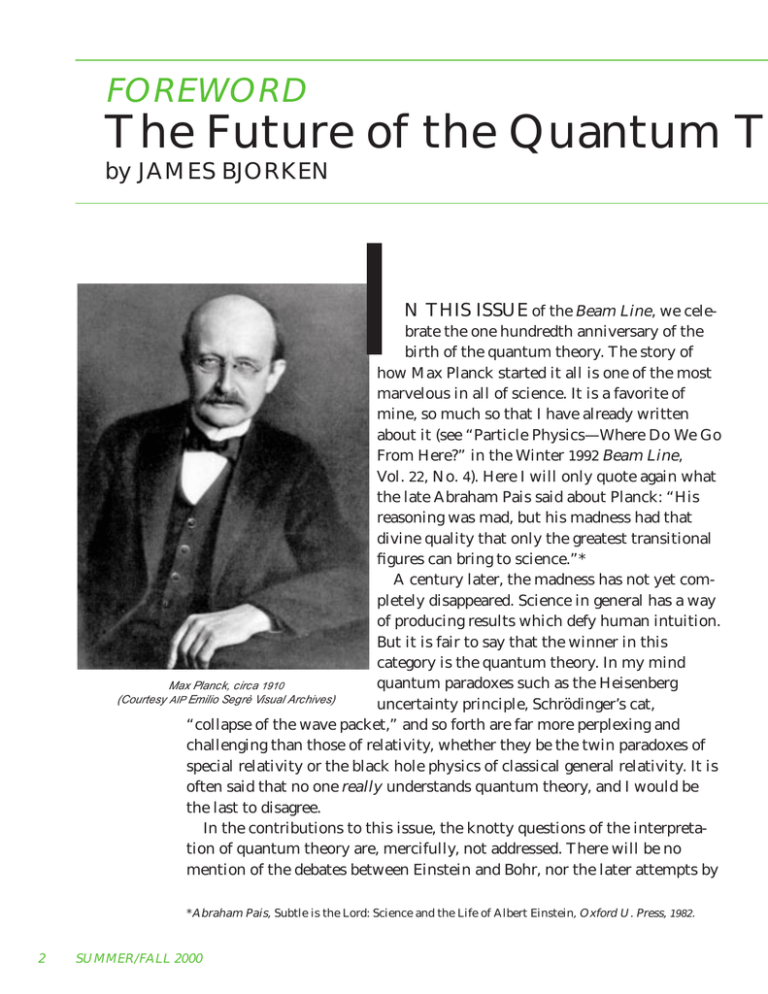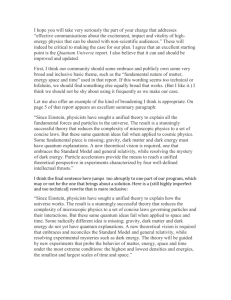I The Future of the Quantum T FOREWORD by JAMES BJORKEN
advertisement

FOREWORD The Future of the Quantum T by JAMES BJORKEN I N THIS ISSUE of the Beam Line, we cele- brate the one hundredth anniversary of the birth of the quantum theory. The story of how Max Planck started it all is one of the most marvelous in all of science. It is a favorite of mine, so much so that I have already written about it (see “Particle Physics—Where Do We Go From Here?” in the Winter 1992 Beam Line, Vol. 22, No. 4). Here I will only quote again what the late Abraham Pais said about Planck: “His reasoning was mad, but his madness had that divine quality that only the greatest transitional figures can bring to science.”* A century later, the madness has not yet completely disappeared. Science in general has a way of producing results which defy human intuition. But it is fair to say that the winner in this category is the quantum theory. In my mind quantum paradoxes such as the Heisenberg Max Planck, circa 1910 (Courtesy AIP Emilio Segrè Visual Archives) uncertainty principle, Schrödinger’s cat, “collapse of the wave packet,” and so forth are far more perplexing and challenging than those of relativity, whether they be the twin paradoxes of special relativity or the black hole physics of classical general relativity. It is often said that no one really understands quantum theory, and I would be the last to disagree. In the contributions to this issue, the knotty questions of the interpretation of quantum theory are, mercifully, not addressed. There will be no mention of the debates between Einstein and Bohr, nor the later attempts by *Abraham Pais, Subtle is the Lord: Science and the Life of Albert Einstein, Oxford U. Press, 1982. 2 SUMMER/FALL 2000 Paul Ehrenfest heory Bohm, Everett, and others to find interpretations of the theory different from the original “Copenhagen interpretation” of Bohr and his associates. Instead, what is rightfully emphasized is the overwhelming practical success of these revolutionary ideas. Quantum theory works. It never fails. And the scope of the applications is enormous. As Leon Lederman, Nobel Laureate and Director Emeritus of Fermilab, likes to point out, more than 25 percent of the gross national product is dependent upon technology that springs in an essential way from quantum phenomena.* Nevertheless, it is hard not to sympathize with Einstein and feel that there is something incomplete about the present status of quantum theory. Perhaps the equations defining the theory are not exactly correct, and corrections will eventually be defined and their effects observed. This is not a popular point of Albert Einstein and Neils Bohr in the late 1920s. (Courtesy AIP Emilio Segrè Visual Archives) view. But there does exist a minority school of thought which asserts that only for sufficiently small systems is the quantum theory accurate, and that for large complex quantum systems, hard to follow in exquisite detail, there *Leon Lederman, The God Particle (If the Universe is the Answer, What is the Question?), Houghton Mifflin, 1993. BEAM LINE 3 may be a small amount of some kind of extra intrinsic “noise” term or nonlinearity in the fundamental equations, which effectively eliminates paradoxes such as the “collapse of the wave packet.” Down through history most of the debates on the foundations of quantum theory produced many words and very little action, and remained closer to the philosophy of science than to real experimental science. John Bell brought some freshness to the subject. The famous theorem that bears his name initiated an experimental program to test some of the fundamentals. Nevertheless, it would have been an enormous shock, at least to me, if any discrepancy in such experiments had been found, because the searches involved simple atomic systems, not so different from elementary particle systems within which very subtle quantum effects have for some time been clearly demonstrated. A worthy challenge to the quantum theory in my opinion must go much further and deeper. What might such a challenge be? At present, one clear possibility which is actively pursued is in the realm of string theory, which attempts an extension of Einstein gravity into the domain of very short distances, where quantum effects dominate. In the present incarnations, it is the theory of gravity that yields ground and undergoes modifications and generalizations, with the quantum theory left essentially intact. But it seems to me that the alternative must also be entertained—that the quantum theory itself does not survive the synthesis. This, however, is easier said than done. And the problem with each option is that the answer needs to be found with precious little assistance from experiment. This is in stark contrast with the development of quantum theory itself, which was driven from initiation to completion by a huge number of experiments, essentially guiding the theorists to the final equations. 4 SUMMER/FALL 2000 Another approach has been recently laid out by Frank Wilczek in a very interesting essay in Physics Today.* He compares the development of the equations of quantum theory with those of Maxwell’s electrodynamics. Both were first laboriously put together from experimental evidence. In both cases the interpretations of what the equations meant came later. In the case of electrodynamics, the ultimate verdict on Maxwell’s equations is that at a deep level they express statements about symmetry. (In physics jargon, Maxwell’s equations express the fact that electrodynamics is gauge invariant and Lorentz covariant.) Wilczek notes that there is no similar deep basis for the equations of quantum mechanics, and he looks forward to statements of symmetry as the future expression of the true meaning of the quantum theory. But if there are such symmetries, they are not now known or at least not yet recognized. Wilczek does cite a pioneering suggestion of Hermann Weyl, which might provide at least a clue as to what might be done. But even if Wilczek is on the right track, there is again the problem that theorists will be largely on their own, with very little help to be expected from experiment. There is, however, a data-driven approach on the horizon. It is a consequence of the information revolution. In principle, quantum systems may be used to create much more powerful computers than now exist. So there is a strong push to develop the concepts and the technology to create large-scale quantum computers. If this happens, the foundations of quantum mechanics will be tested on larger and larger, more complex physical systems. And if quantum mechanics in the large needs to be modified, these computers may not work as they are supposed to. If this happens, it will be just one more example of how a revolution in technology can lead to a revolution in fundamental science. *Frank Wilczek, Physics Today, June 2000, Vol. 53, No. 6, p. 11. BEAM LINE 5







